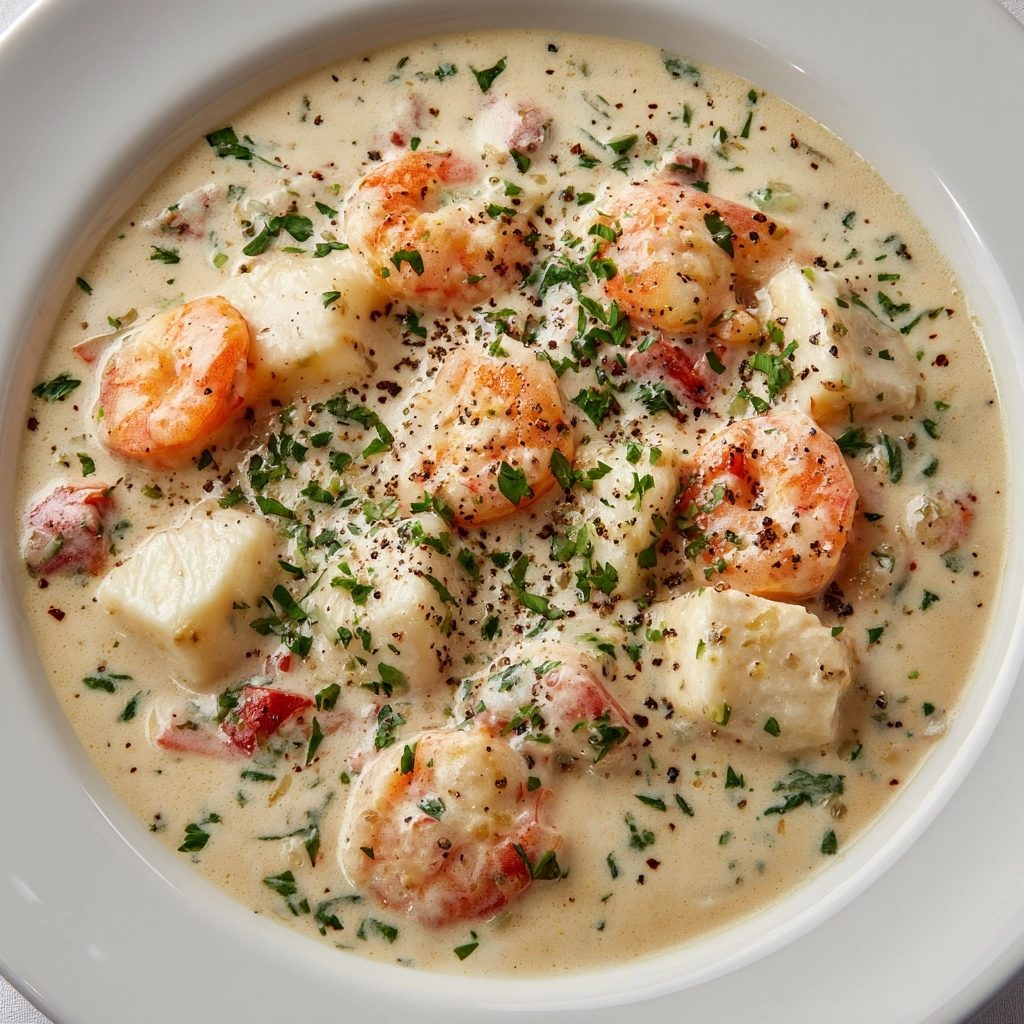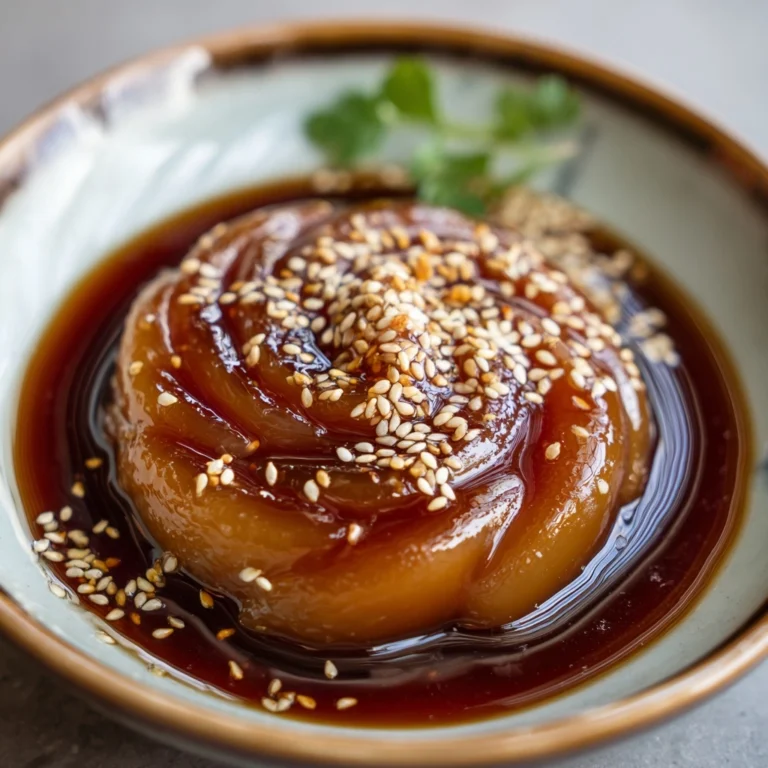Few dishes capture the heart and soul of Atlantic Canada quite like Nova Scotia Seafood Chowder. Creamy, brimming with fresh local seafood, and loaded with tender vegetables, this chowder is pure comfort in a bowl. With each spoonful, you get the briny sweetness of the sea, the earthiness of potatoes, and a symphony of herbs and seasonings that make this a true maritime classic. Whether you’re gathering with friends on a cool evening or just craving a taste of the ocean, this recipe will transport you straight to a cozy Nova Scotian kitchen.

Ingredients You’ll Need
The magic of Nova Scotia Seafood Chowder lies in its simple, high-quality ingredients. Each component brings something special, from the sweet seafood to the silky creaminess and the fresh pop of herbs. Here’s what you’ll need to create this iconic dish at home.
- Unsalted Butter: Adds richness and helps sauté the aromatics for a flavorful base.
- Onion (small, diced): Offers a subtle sweetness and depth that enhances every bite.
- Celery (2 stalks, chopped): Lends a mild crunch and gentle savory note.
- Garlic (2 cloves, minced): Provides a fragrant, aromatic layer that makes the chowder irresistible.
- Potatoes (4 medium, peeled and diced): Give body and heartiness, soaking up the broth beautifully.
- Fish Stock or Seafood Broth (4 cups): Forms the flavorful backbone, infusing the chowder with that authentic maritime taste.
- Heavy Cream (1 cup): Brings a luxurious creaminess to the soup, making it wonderfully indulgent.
- Milk (1 cup): Lightens the chowder just enough, balancing the richness.
- Dried Thyme (1 teaspoon): Adds an herbal note that complements the seafood perfectly.
- Old Bay Seasoning (1 teaspoon): Delivers signature seafood spice, or use your favorite seafood seasoning.
- Salt and Pepper (to taste): Essential for rounding out the flavors—don’t be shy, taste as you go!
- Haddock or White Fish (1/2 pound, cut into chunks): A mild, flaky fish that soaks up all the delicious broth. Substitute with cod or pollock if needed.
- Shrimp (1/2 pound, peeled and deveined): Sweet and tender, they add a delightful texture.
- Scallops (1/2 pound, cut into quarters): Bring a slightly sweet, buttery flavor that’s classic in Nova Scotia chowder.
- Fresh Parsley (1/2 cup, chopped): Brightens the whole dish and adds vibrant color.
- Lemon Juice (2 tablespoons, optional): A little squeeze at the end lifts all the flavors and gives a fresh finish.
How to Make Nova Scotia Seafood Chowder
Step 1: Sauté the Vegetables
Start by melting the butter in a large, heavy-bottomed pot over medium heat. Add the diced onion, chopped celery, and minced garlic. Stir everything together and let the vegetables cook gently for about five minutes. The goal is to soften them and draw out their natural sweetness, creating a savory, aromatic base for your chowder. This step sets the stage for all the wonderful flavors to come.
Step 2: Add Potatoes and Broth
Once the aromatics are soft and fragrant, stir in your peeled and diced potatoes. Pour in the fish stock or seafood broth, making sure the potatoes are fully submerged. Bring everything to a gentle simmer. Let the potatoes cook for about 10 to 12 minutes, or until they’re fork-tender. They’ll start to absorb the flavors of the broth, becoming creamy and delicious—just what you want in a traditional Nova Scotia Seafood Chowder.
Step 3: Add Cream and Seasonings
With your potatoes cooked through, it’s time to turn your chowder creamy and irresistible. Pour in the heavy cream and milk, then sprinkle in the dried thyme, Old Bay seasoning, and a generous pinch of salt and pepper. Stir well, and bring the mixture back to a gentle simmer. You’ll see the chowder begin to thicken slightly, and the aroma filling your kitchen will be absolutely mouthwatering!
Step 4: Add the Seafood
Now for the main event—gently add the chunks of haddock or white fish, shrimp, and quartered scallops. Let them simmer in the creamy broth for about 5 to 7 minutes. The seafood should be just cooked through and tender, their flavors mingling beautifully with the rest of the chowder. Be careful not to overcook, as you want the seafood to remain juicy and delicate.
Step 5: Finish with Parsley and Lemon
To bring everything together, stir in the chopped fresh parsley and, if you like, a splash of lemon juice for brightness. Taste and adjust the seasoning if needed. The parsley adds a burst of freshness and color, while the lemon lifts all the flavors, making your Nova Scotia Seafood Chowder truly sing.
Step 6: Serve and Enjoy
Ladle your steaming chowder into bowls and serve with slices of crusty bread or a handful of crisp crackers. Sit back and enjoy the cozy, seaside flavors of this classic dish, whether you’re at home or dreaming of the Atlantic coast.
How to Serve Nova Scotia Seafood Chowder

Garnishes
A sprinkle of fresh parsley or chives adds a pop of color and a fresh note that balances the richness of the chowder. For an extra-special touch, a few grinds of black pepper and a drizzle of good olive oil can make each bowl look (and taste) restaurant-worthy. If you love a touch of citrus, a wedge of lemon on the side lets everyone brighten up their chowder to taste.
Side Dishes
Nova Scotia Seafood Chowder is lovely all on its own, but it’s even better with classic sides. Serve it with thick slices of warm, crusty bread—perfect for dunking and soaking up every last drop. Buttery biscuits, oyster crackers, or a simple green salad also pair beautifully, rounding out your meal without stealing the show from the chowder.
Creative Ways to Present
For a fun twist, serve your chowder in small sourdough bread bowls or pretty mugs for a cozy gathering. Mini portions in shot glasses or espresso cups make a delightful appetizer for a holiday party. You can even top each bowl with a seared scallop or a swirl of herbed crème fraîche for a gourmet touch that will wow your guests.
Make Ahead and Storage
Storing Leftovers
If you find yourself with leftover Nova Scotia Seafood Chowder (lucky you!), transfer it to an airtight container and refrigerate. It will keep well for up to 2 days. The flavors meld beautifully overnight, making each reheated bowl even more delicious.
Freezing
While you can freeze Nova Scotia Seafood Chowder, keep in mind that the cream and potatoes may change texture once thawed. If you do freeze it, use a freezer-safe container and enjoy it within 2 months. For best results, cool the chowder completely before freezing and reheat gently to maintain its creamy consistency.
Reheating
When reheating refrigerated or thawed chowder, do so slowly over low to medium heat. Stir often to prevent the cream from separating and the seafood from becoming rubbery. If the chowder seems a bit thick, add a splash of milk or broth to loosen it up and bring back that velvety texture.
FAQs
Can I use different types of seafood in Nova Scotia Seafood Chowder?
Absolutely! Feel free to mix and match your favorite seafood—clams, mussels, lobster, or even salmon can make wonderful additions. Just be mindful of different cooking times so everything stays perfectly tender.
Is it possible to make the chowder dairy-free?
Yes, you can swap the heavy cream and milk for coconut milk or a rich, unsweetened plant-based cream. The texture will be slightly different, but you’ll still get a luscious, satisfying chowder.
What if I don’t have fish stock or seafood broth?
Chicken or vegetable broth works in a pinch, though you’ll miss a bit of that authentic ocean flavor. If you have shrimp shells or fish bones, simmer them with water and aromatics for a quick DIY seafood stock.
Can I prepare Nova Scotia Seafood Chowder in advance?
You can make the base (through the potato and broth step) a day ahead, then add the cream and seafood right before serving for the freshest flavor and best texture.
How do I know when the seafood is cooked just right?
Seafood cooks quickly! Once it turns opaque and is just firm to the touch, it’s done. Overcooking can make it tough, so keep a close eye during the final simmer.
Final Thoughts
If you’re searching for a bowl of pure coastal comfort, Nova Scotia Seafood Chowder is the answer. It’s a recipe that brings people together, warms the soul, and delivers a little taste of the Atlantic no matter where you are. Gather your favorite seafood and give this chowder a try—you’ll be hooked after the very first spoonful!
Print
Nova Scotia Seafood Chowder Recipe
- Prep Time: 10 minutes
- Cook Time: 30 minutes
- Total Time: 40 minutes
- Yield: 6 servings 1x
- Category: Soup
- Method: Sautéing and Simmering
- Cuisine: Canadian
- Diet: Non-Vegetarian
Description
This Nova Scotia Seafood Chowder is a rich and creamy soup brimming with fresh seafood, tender potatoes, and traditional seasonings. Perfectly balanced with the flavors of haddock, shrimp, and scallops simmered in a luscious broth, this chowder is a comforting and satisfying meal that captures the essence of coastal Canadian cuisine.
Ingredients
Base Ingredients
- 2 tablespoons unsalted butter
- 1 small onion, diced
- 2 stalks celery, chopped
- 2 cloves garlic, minced
Broth and Vegetables
- 4 medium potatoes, peeled and diced
- 4 cups fish stock or seafood broth
Dairy and Seasonings
- 1 cup heavy cream
- 1 cup milk
- 1 teaspoon dried thyme
- 1 teaspoon Old Bay seasoning (or seafood seasoning)
- Salt and pepper to taste
Seafood
- 1/2 pound haddock or other white fish, cut into chunks
- 1/2 pound shrimp, peeled and deveined
- 1/2 pound scallops, cut into quarters
Finishing Touches
- 1/2 cup fresh parsley, chopped
- 2 tablespoons lemon juice (optional, for a fresh finish)
Instructions
- Sauté Vegetables: In a large pot, melt the butter over medium heat. Add the diced onion, celery, and garlic, and sauté until softened and fragrant, about 5 minutes.
- Add Potatoes and Broth: Incorporate the diced potatoes into the pot, then pour in the fish stock or seafood broth. Bring the mixture to a gentle simmer and cook for 10 to 12 minutes, or until the potatoes are tender but not falling apart.
- Add Cream and Seasonings: Stir in the heavy cream, milk, dried thyme, Old Bay seasoning, salt, and pepper. Return the chowder to a simmer, stirring occasionally to combine all the flavors thoroughly.
- Add Seafood: Gently add the pieces of haddock, shrimp, and scallops to the pot. Cook for an additional 5 to 7 minutes, or until the seafood is fully cooked, opaque, and tender, and the flavors have melded together.
- Finish with Parsley and Lemon: Stir in the fresh chopped parsley and lemon juice if using. Adjust the seasoning with more salt and pepper to taste, ensuring the chowder is perfectly balanced.
- Serve: Ladle the hot seafood chowder into bowls and serve immediately. It pairs wonderfully with crusty bread or crackers for a delightful meal.
Notes
- Use fresh seafood for the best flavor and texture; frozen shrimp and scallops can be used but thaw completely before cooking.
- Old Bay seasoning can be substituted with any good-quality seafood seasoning or a mix of paprika, celery salt, and cayenne pepper.
- For a thicker chowder, mash some of the potatoes in the pot before adding the seafood.
- Adjust the cream and milk quantities based on preferred chowder thickness.
- Lemon juice adds a bright finish but is optional depending on taste preference.
- Leftover chowder can be refrigerated for up to 2 days but is best enjoyed fresh.
Nutrition
- Serving Size: 1 bowl (approximately 1 and 1/2 cups)
- Calories: 320
- Sugar: 4g
- Sodium: 680mg
- Fat: 18g
- Saturated Fat: 11g
- Unsaturated Fat: 6g
- Trans Fat: 0g
- Carbohydrates: 20g
- Fiber: 3g
- Protein: 20g
- Cholesterol: 95mg








